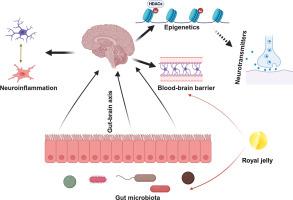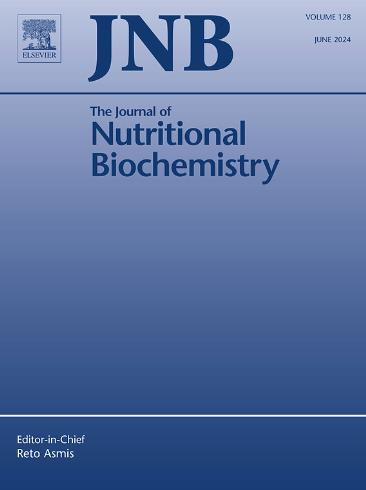蜂王浆的神经调节作用。
IF 4.9
2区 医学
Q1 BIOCHEMISTRY & MOLECULAR BIOLOGY
引用次数: 0
摘要
蜂王浆(RJ)是蜂王专用的一种营养丰富的分泌物,具有多种生物活性。由于对RJ对中枢神经系统(CNS)相关功能和病理的影响的研究有限,本文试图对RJ在哺乳动物和人类中神经调节功能的最新进展进行综述。本综述的另一个中心目的是总结RJ神经调节作用的已知机制。RJ成分首先讨论了它们与神经保护的联系,重点是蜂王酸(QBA, 10-HDA,反式10-羟基-2-十烯酸),mrjp(主要的蜂王浆蛋白)和微生物群。RJ的神经调节作用可分为三个领域:中枢神经系统的基本功能,包括学习和记忆、体外神经元细胞活性和社会行为;神经系统疾病,如阿尔茨海默病(AD)、帕金森病(PD)、焦虑和抑郁;毒害神经的活动。在机制方面,RJ调节神经炎症,这是神经系统疾病的关键驱动因素,并在其他表观遗传调节剂中作为HDAC(组蛋白去乙酰化酶)抑制剂,影响中枢神经系统的基因表达。新出现的证据也暗示了微生物-肠道-大脑(MGB)轴,RJ改变肠道微生物群组成,随后影响大脑功能。最后,我们概述了关键的研究方向,包括临床意义,与其他蜜蜂产品的比较,表观遗传机制,以及RJ在重塑社会行为中的未开发作用。本综述旨在巩固我们对RJ神经调节作用的认识,强调其在营养和药物方面对神经系统疾病的治疗潜力。本文章由计算机程序翻译,如有差异,请以英文原文为准。

Neuroregulatory effect of royal jelly
Royal jelly (RJ), a nutrient-rich secretion fed exclusively to queen honeybees, exhibits diverse biological activities. Due to limited insights into its effects on central nervous system (CNS)-related functions and pathologies, this review attempts to recapitalize the recent advances of neuroregulatory function of RJ in mammals and humans. Another central aim of this review is to summarize the known mechanisms underlying the neuroregulatory effect of RJ. RJ components were first discussed concerning their link to neuroprotection, with a focus on the queen bee acid (QBA, 10-HDA, trans-10‑hydroxy-2-decenoic acid), MRJPs (major royal jelly proteins), and microbiota. The neuroregulatory implications of RJ are then categorized into three domains: fundamental CNS functions, including learning and memory, in vitro neuronal cell activity and social behavior; neurological disorders such as Alzheimer's disease (AD), Parkinson’s disease (PD), anxiety and depression; neurotoxic events. In terms of mechanistic insights, RJ modulates neuroinflammation, a pivotal driver of neurological disorders, and acts as an HDAC (histone deacetylase) inhibitor among other epigenetic regulators, influencing gene expression in the CNS. Emerging evidence also implicates the microbiota-gut-brain (MGB) axis, where RJ alters gut microbiota composition, subsequently impacting brain function. Finally, we outline critical research directions, including clinical significance, comparisons with other honeybee products, epigenetic mechanisms, and RJ’s untapped role in reshaping social behaviors. This review aims to consolidate our knowledge on the neuroregulatory effects of RJ, underscoring its therapeutic potential for neurological conditions in both nutritional and pharmaceutical contexts.
求助全文
通过发布文献求助,成功后即可免费获取论文全文。
去求助
来源期刊

Journal of Nutritional Biochemistry
医学-生化与分子生物学
CiteScore
9.50
自引率
3.60%
发文量
237
审稿时长
68 days
期刊介绍:
Devoted to advancements in nutritional sciences, The Journal of Nutritional Biochemistry presents experimental nutrition research as it relates to: biochemistry, molecular biology, toxicology, or physiology.
Rigorous reviews by an international editorial board of distinguished scientists ensure publication of the most current and key research being conducted in nutrition at the cellular, animal and human level. In addition to its monthly features of critical reviews and research articles, The Journal of Nutritional Biochemistry also periodically publishes emerging issues, experimental methods, and other types of articles.
 求助内容:
求助内容: 应助结果提醒方式:
应助结果提醒方式:


